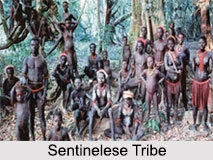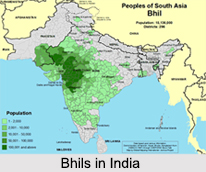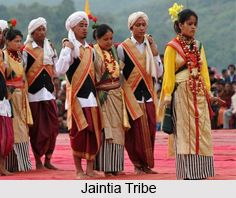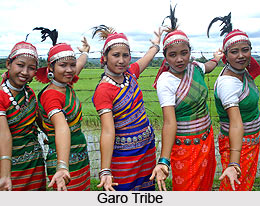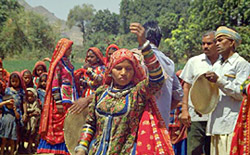Introduction
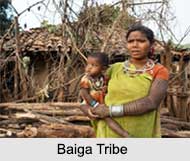 Baiga Tribe is a primitive Dravidian tribe located in the Indian states of Jharkhand, Bihar, Odisha and West Bengal and also in Madhya Pradesh and Maharashtra. These are minor scheduled tribes, still dependent upon forest resources. They dwell in the remotest regions of the state, mostly in the forested regions and hilly areas of Jharkhand. The Baiga tribe is also known as "Bhumia" which means "lord of the soil".
Baiga Tribe is a primitive Dravidian tribe located in the Indian states of Jharkhand, Bihar, Odisha and West Bengal and also in Madhya Pradesh and Maharashtra. These are minor scheduled tribes, still dependent upon forest resources. They dwell in the remotest regions of the state, mostly in the forested regions and hilly areas of Jharkhand. The Baiga tribe is also known as "Bhumia" which means "lord of the soil".
Origin of Baiga Tribe
Baiga is a primitive Dravidian tribe whose initial homeland was in the north-east but now they have shifted from Bihar to Jharkhand. In 1911 their population was around 30000 but later their population dropped considerable when most of them got converted to Hinduism. The reason behind this was that few areas have zamindars, landowners whose family would claim a more respectable family background. With time they have been admitted to a respectable position in the society. They have now left there original language and have adopted the Indo- Aryan form of Language. Sometimes the Baigas are referred to as the Bhumaior, meaning `Lord of the Soil.` Being the most ancient residents, the Baigas have taken up the occupation of the priests in the area they reside. In certain places the decision of the Baigas are sought after and their judgement is considered to be final verdict.
There are certain reasons which explain that the Baigas are a subdivision of the Bhuiya Tribe of Chotanagpur. Later they have adopted their name as Baiga when they migrated to the Central Province.
Legend associated with the Origin of Baiga
To add to their glory, the Baigas have a legend attached to their origin. According to the legend God had first created Nanga Baiga and Nagi Baigin. He had then given them the choice to select the occupation through which they would make their living. The two of them desired to live in the jungle by felling trees and led their lives by following this mode of occupation. Two sons were born to them. One of them remained as a Baiga and the other of them Gong and tilled the soil. The two brothers married their own two sisters. Each couple had their own children. The elder are regarded as the ancestors of Baigas while the younger couple became the descendants of the Gonds and of other human race.
The other version of the legend says that the first Baiga that cut down two thousand sal trees in a day, god then advised him to sprinkle few grants of kutki on the ashes and then retire and go for a deep slumber for few months. When he would get up he will be able to reap rich harvest. This way the method of shifting cultivation was initiated. According to another story the the Nanga Baigs and the Nagi Baigin lived on a hill. They would sometimes suspend from their houses a bamboo mat tied up to a pole which would represent a flag. They had seen it once being attached in the palace of a Baiga king.
It is sometimes considered that the original habitat of the Baigas may have the Chattisgarh Plain and the hills surrounding it. Many estates of the hills are owned by the landowners of the tribes who are offshoots of the Baigas like the Bhainas and the Binjhwars. They have been first observed by the English officers of the nineteenth century. Their villages were found to be located in far off places from the cultivated country. No roads or well built paths connected them with the rest of the country or other inhabited places. They settled in small huts safely hidden from others. They are rarely seen except when approached closely or visited by some outsider.
Society of Baiga Tribe
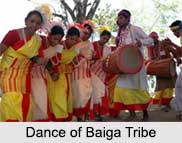 Society of Baiga Tribe
Society of Baiga Tribe
There are altogether seven sub-divisions or sub-castes of Baiga Tribe namely Binjhwar, Bharotia, Raibhaina, Kathbhaina, Narotia or Nahar, Kondwan or Kundi and Gondwaina. Of these the Binjhwar, Bharotia and Narotia are well known. The name of the Binjhwar tribe is said to have been derived from Vindhya mountain range. In Baiga tribal societies, the rule of exogamy is strictly observed. In Kawardha, it is believed that the three sub-castes intermarry but they do not eat together. In Balaghat, Bharotias and Narotias can intermarry as well as eat together. Each of the sub-tribe has been divided into several exogamous sects. The names of these sub-sects are quite similar with those of the Gond tribe. Polygamy is also allowed in these tribal societies.
Religion of Baiga Tribe
The religion of the Baigas is primarily animism. Their principal deity is Bura Deo. The deity is believed to reside in the Saal Saj Tree which is worshipped by the Baigas in the month of May (jeth) during which goats, coconuts, fowls, and liquor of the new mahua crop is offered to the deity. For the village land and boundaries another deity, Thakur Deo is worshipped who is appeased with a white goat.
The Baigas who plough the field observe a ceremony before the commencement of the rains. The ceremony is called the Bidri. During the ceremony a handful of each type of grain that has been sown is collected and given to the priest by each cultivator. The priest then mixes the grains together and sows a little of it under tree where Thakur Deo resides.
After this the priest returns back a little of the grains to each cultivator and keeps the rest with him. The individual cultivator then sows the given seeds in the centre of his field over which the crops will grow. This ceremony is believed to reap rich harvest.
Dulha Deo is another god worshiped by the Baigas. This god is believed to ward off all types of diseases and accidents. He is worshipped by offering him a fowl or goat of reddish colour. Bhimsen is regarded as the deity of rainfall and Mother God or Dharti Mata is considered as the wife of Thakur Deo. Hence she should also be appeased for good harvest. The grains before being sowed are worshipped at the threshing floor and water and liquor are sprinkled on it. Woship of Hindu gods are also prevalent among few of the Baigas but not in an orthodox manner. Hence it becomes sacrilege on the part of the Hindus to offer animal sacrifices to the Sun God, Narayam Deo but the Baigas offer him a special offering, the pig.
The animal that is to be sacrificed is permitted to wander loose for two to three years before it is being killed. The animal which is being killed for sacrifice is laid on his back in the threshold of the doorway. Across its stomach a plank of Saal saj wood is placed on which six men on either side sit or stand on it. The fore and the hind legs of the pig are pulled backward and forward until the animal is crushed to death. During the sacrifice the men sing or shout sacrificial mantras. The head and feet of the animal is cut off and offered to the god.
The spirits of the married couples are believed to live in the streams and the sprits of the unmarried ones reside in the trees. The later one is usually assumed to become ghost or malevolent spirits. Demoniacal possession is warded off through a popular remedy. Human hair is mixed with red chillies and cow dung and burnt in front of the person possessed with spirits and it is thought that the awful smell produced will drive away the spirit. The Baigas believe in many superstitions. They believe that if a single crow is seen bathing in the stream it is considered as a sign of death. If a cock crows in the night it must be immediately killed and thrown into darkness. Woodpeckers and owls are also considered to be bad omens. The Baigas do not believe in fresh birth or rebirth.
The Baigas serve as priests of the Gonds because as they are the early residents of the place they are believed to have better acquaintance with the local deities. They have in-depth knowledge of the medicinal uses of the trees, herbs and the roots have been instrumental in providing effective cures when even the local doctors have failed. The priests of the village are skilful sorcerers and are acquainted with the unseen world. Even the Baigas are invited to villages or towns to give aid when they were attacked by cholera. It is believed that their visit would give them great relief. During their visit, the Baiga priests would go around the village and pull out few straws from each house. Later he would burn them down in front of the village deity, Khermata. Along with the straws he would also offer a chicken for each homestead. If this remedy does not work then goats are sacrificed and finally pigs are sacrificed. By this time it is assumed that the disease will be warded off. Hus with time the Baigas have attained a respectable position in the villages.
Culture of Baiga Tribe
The Baiga culture is full of proverbs, tales and rituals. They are stretched in different states of India like Madhya Pradesh, Uttar Pradesh, Chhattisgarh and Jharkhand. They follow different types of customs that are different from other tribes.
Tattooing Among Baiga Tribe
Among the women tattooing is an integral part. They decorate different parts of their body with different tattoo marks. Long strips of parallel lines are made on the face, especially on the fore head. Different types of marks are made like moon, triangles, crosses, dots and others. Dots or small lines are also made on the cheek or chin, below the neck and on the back. The women who specialise as tattooing artists are called Godharins and they belong to the Ojha, Badni and Dewar tribes of M.P. They are well aware about the different types of tattoos favoured by various tribes. Tattooing amongst the tribes begins from the winter season and continues until summer.
Tradition of Folk Medicine among Baiga Tribe
The tradition of folk medicine is still followed by the Baigas. The Baiga men are experts having indepth knowledge about medicines. Various parts of plants are used as herbal medicines. For any type of body ailments like body pain, headache, cough, stomach pain, cold, fever, cut or small accident etc, the Baigas treat them with their own medicines.
Birth and Death Rituals among Baiga Tribe
There are certain rituals attached to the birth and death of the Baigas. After the birth of a child a woman is considered to be impure for a month. A purification ceremony is organized where the child`s name is also finalized. Children who are physically handicapped are given names accordingly like Langra (lame), Bahira (deaf).
Among the Baigas the dead people are buried but the aged people are burnt as a sign of honour. Bodies are laid naked with their head pointing the south direction. A person of importance is buried with two; three rupees or cigarettes and tobacco are kept. In some instances a rupee is thrust into the mouth of the dead person which is later recovered by the man`s daughter or sister who wears it in her amulet. On top of the grave a platform is made on which a stone is raised. In times of trouble his relatives worship the place. During the funeral two fowls, one black and one white are taken to the streams and are eaten there. A portion is also kept for the deceased one. For a period of two to three days mourning is observed. During this all household chores are discontinued and food is provided by their friends. A different set of rituals are followed if a man is killed by a tiger. When such an incident takes place, a Baiga priest is called who visits the spot where the incident took place. He makes a small cone of the blood stained earth which should symbolize either the deceased man or his relatives. The priest then goes around on his hands and knees and performs activities that indicate the tiger. He also takes a lump of blood stained earth in his mouth and the relatives standing at a distance approaches and strikes the priest with a stick on his back. This action means the tiger has been killed or has been left harmless and the priest then lets off the mud into the hands one of the relative. The mud is then placed in an ant hill and a pig is sacrificed over it. The next a pig is taken and a mark is made which represents the dead man`s name and is then left in the jungle. This ceremony is believed to lay back the deceased one`s spirit and also prevents the tiger from causing any harm.
Occupation of Baiga Tribe
Many of the people who belong to the tribe make medicines by profession, though their chief occupation has been shifting cultivation. Earlier, the Baigas practiced shifting cultivation. Presently several attempts have been taken by the government to train them about regular cultivation process. In recent times they have discarded shifting cultivation.
Festivals of Baiga Tribe
Karma and Sarhul are the two main festivals celebrated by the Baiga tribe of Jharkhand. Sarhul is celebrated during the spring season when the Shaal trees get new leaves. The Karma festival is a festival of agriculture and is very sacred to the Baiga tribe and also the other tribal people of Jharkhand, Madhya Pradesh and Bihar.
Marriage Rituals of Baiga Tribe
The marriage rituals customs of the Baiga Tribe spell out that a man should not take a wife from his own sept or from any other who worships the same number of gods. He is allowed to marry his mother`s sept. Among the Baigas they are allowed to marry their first cousins. Adult marriage is practised among them and the proposal is forwarded from the side of the bride. In some localities the girl is allowed to choose her own husband. Dowry system is practised and a fixed price is paid to the bride`s parents. Alternatively even the prospective husband serves the father in law for two years. After the commencement of one year the marriage is conducted. Orphan boys who have no one to arrange marriage for them take the service of their wife. Three are three ceremonies prior to the marriage. The first one takes place after the birth of the two children. The ceremony of betrothal is arranged. The second ceremony is an authorization of the first ceremony. The boy`s parents arrange for a feast on both the occasions. The final ceremony is celebrated when the children grow up and reach their marriageable age. After a feast from the boy`s father the wedding day is fixed. To determine the marriage if the marriage would be promising or not, two grains are dropped in a pot. If the two points of the grains meet then the marriage is considered to be auspicious. In case they do not meet, a second pair of grains is dropped. If they meet the next time it is thought that the couple will quarrel with each other after a period of time and the wife will return back to her father`s house. If neither of the cases happen then a third time grains are dropped in the pot and it is concluded that the wife will elope with someone leaving behind her husband within a short span of their marriage.
The wedding procession begins from the bridegroom`s house and is welcomed by the bride`s father`s outside the village. It is customary that the boy should ride an elephant while going to marry. As it is not affordable to get an elephant, two wooden bedsteads are fastened together and it is covered with a blanket and with a black cloth is tied like a trunk in front. The elephant pretend to charge and crush down the marriage precession till a rupee is paid. Then the two parties embrace each other and advance for the marriage. During wedding ceremony the boy and the girl throw fried rice on each other until they get tired. They then walk three to seven times around the marriage post with their clothes tied up. Earlier the wedding couple used to go into the jungle to spend their wedding night. This custom has now been discarded.
Widow remarriage is permissible and the widow is supposed though not compulsory to marry her deceased husband`s younger brother. If the girl chooses another husband she pays an amount to her brother in law. This ceremony comprises of gifting of bangles and new clothes by the suitor to his new bride. The bride in return pours some tepid water strained with turmeric over his head. Divorce is also allowed among them. Divorce between the husband and the wife is arranged by breaking a straw in front of the caste panchayat. If the divorced woman stays back in the village and does not remarry, the husband is responsible for her and her children`s livelihood. A divorced woman is not allowed to marry without the approval of the panchayat and so long her husband is alive. She needs to stay single till then. Polygamy is also practised but it is conditional.

















